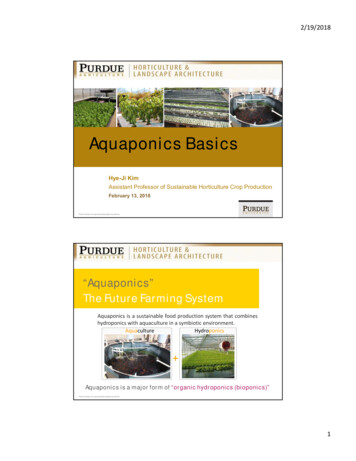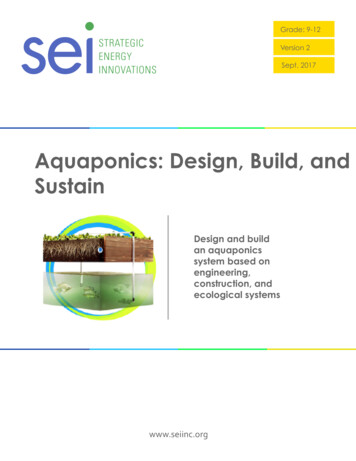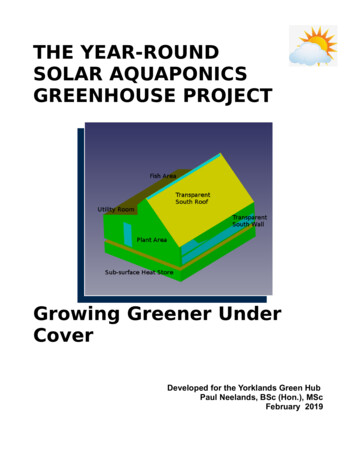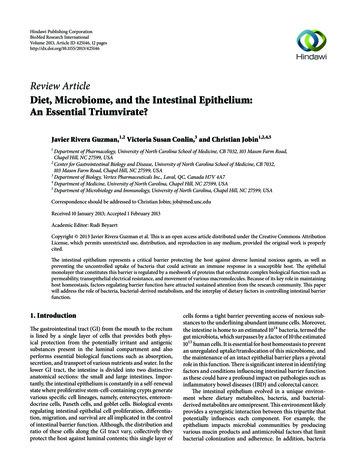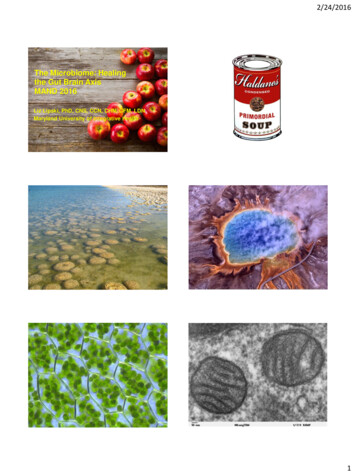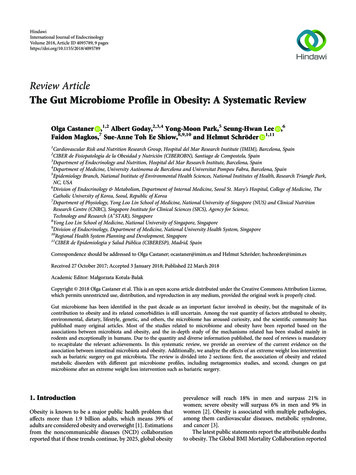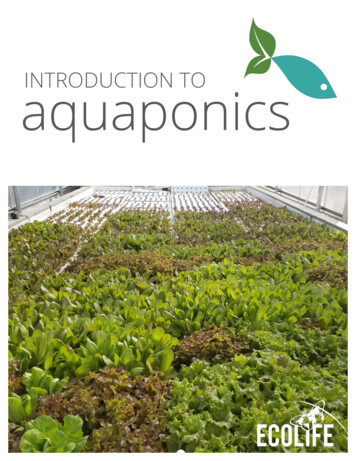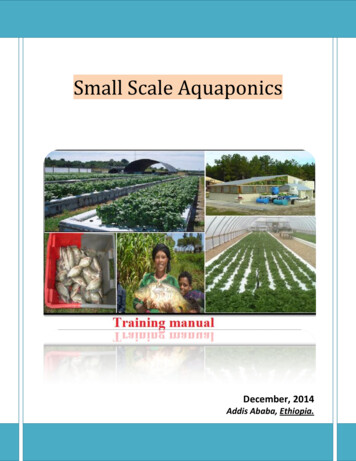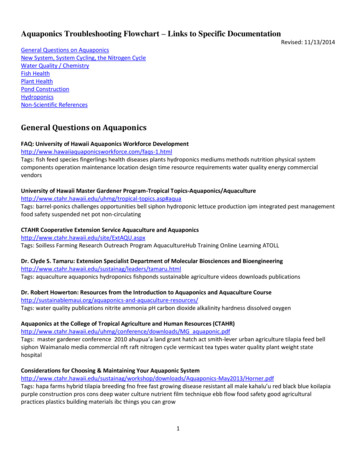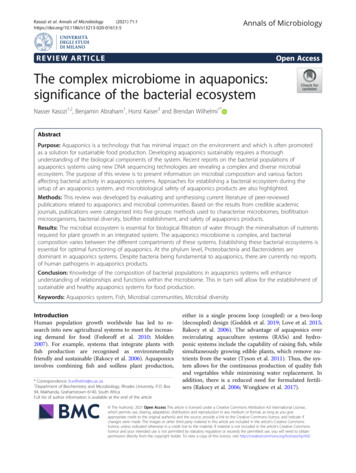
Transcription
Annals of MicrobiologyKasozi et al. Annals of Microbiology(2021) EW ARTICLEOpen AccessThe complex microbiome in aquaponics:significance of the bacterial ecosystemNasser Kasozi1,2, Benjamin Abraham1, Horst Kaiser3 and Brendan Wilhelmi1*AbstractPurpose: Aquaponics is a technology that has minimal impact on the environment and which is often promotedas a solution for sustainable food production. Developing aquaponics sustainably requires a thoroughunderstanding of the biological components of the system. Recent reports on the bacterial populations ofaquaponics systems using new DNA sequencing technologies are revealing a complex and diverse microbialecosystem. The purpose of this review is to present information on microbial composition and various factorsaffecting bacterial activity in aquaponics systems. Approaches for establishing a bacterial ecosystem during thesetup of an aquaponics system, and microbiological safety of aquaponics products are also highlighted.Methods: This review was developed by evaluating and synthesising current literature of peer-reviewedpublications related to aquaponics and microbial communities. Based on the results from credible academicjournals, publications were categorised into five groups: methods used to characterise microbiomes, biofiltrationmicroorganisms, bacterial diversity, biofilter establishment, and safety of aquaponics products.Results: The microbial ecosystem is essential for biological filtration of water through the mineralisation of nutrientsrequired for plant growth in an integrated system. The aquaponics microbiome is complex, and bacterialcomposition varies between the different compartments of these systems. Establishing these bacterial ecosystems isessential for optimal functioning of aquaponics. At the phylum level, Proteobacteria and Bacteroidetes aredominant in aquaponics systems. Despite bacteria being fundamental to aquaponics, there are currently no reportsof human pathogens in aquaponics products.Conclusion: Knowledge of the composition of bacterial populations in aquaponics systems will enhanceunderstanding of relationships and functions within the microbiome. This in turn will allow for the establishment ofsustainable and healthy aquaponics systems for food production.Keywords: Aquaponics system, Fish, Microbial communities, Microbial diversityIntroductionHuman population growth worldwide has led to research into new agricultural systems to meet the increasing demand for food (Fedoroff et al. 2010; Molden2007). For example, systems that integrate plants withfish production are recognised as environmentallyfriendly and sustainable (Rakocy et al. 2006). Aquaponicsinvolves combining fish and soilless plant production,* Correspondence: b.wilhelmi@ru.ac.za1Department of Biochemistry and Microbiology, Rhodes University, P.O. Box94, Makhanda, Grahamstown 6140, South AfricaFull list of author information is available at the end of the articleeither in a single process loop (coupled) or a two-loop(decoupled) design (Goddek et al. 2019; Love et al. 2015;Rakocy et al. 2006). The advantage of aquaponics overrecirculating aquaculture systems (RASs) and hydroponic systems include the capability of raising fish, whilesimultaneously growing edible plants, which remove nutrients from the water (Tyson et al. 2011). Thus, the system allows for the continuous production of quality fishand vegetables while minimising water replacement. Inaddition, there is a reduced need for formulated fertilisers (Rakocy et al. 2006; Wongkiew et al. 2017). The Author(s). 2021 Open Access This article is licensed under a Creative Commons Attribution 4.0 International License,which permits use, sharing, adaptation, distribution and reproduction in any medium or format, as long as you giveappropriate credit to the original author(s) and the source, provide a link to the Creative Commons licence, and indicate ifchanges were made. The images or other third party material in this article are included in the article's Creative Commonslicence, unless indicated otherwise in a credit line to the material. If material is not included in the article's Creative Commonslicence and your intended use is not permitted by statutory regulation or exceeds the permitted use, you will need to obtainpermission directly from the copyright holder. To view a copy of this licence, visit http://creativecommons.org/licenses/by/4.0/.
Kasozi et al. Annals of Microbiology(2021) 71:1A feature of aquaponics is the reliance on the bacterialecosystem. Most fish species retain 20–30% of ingesteddietary nitrogen (Schreier et al. 2010), and 70–80% is released into the water as waste (Krom et al. 1995).Digested protein is excreted mostly as ammonium(NH4 ) through the gills (Tyson et al. 2011; Wongkiewet al. 2017). NH4 can also accumulate because of bacterial decomposition of organic matter such as proteinand nitrogenous compounds in uneaten feed (Roostaand Hamidpour 2011). Ammonium nitrogen (NH4 -N)excreted by fish provides the major form of nitrogen essential for plant growth (Roosta and Hamidpour 2011;Wongkiew et al. 2017). Biological nitrification of thenutrient-rich fish tank water forms nitrate (NO3 ) whichis assimilated by plants (Tyson et al. 2011). Nitrification converts NH4 , which becomes harmful to fish atincreasing pH, to NO3 , thereby maintaining waterquality. In addition, in weakly buffered water, nitrification can decrease the pH value of the system water,while bacterial denitrification can increase water pH.Therefore, the composition of the bacterial ecosystemis essential to aquaponics farming (Rakocy et al. 2006;Wongkiew et al. 2017).Comprehensive reviews on the relative distribution ofmicroorganisms have been published in the context ofRASs and with emphasis on these systems’ biofiltration(Rurangwa and Verdegem 2015; Schreier et al. 2010).However, those reviews only considered recirculatingsystems without plants. In addition, aquaponics systemsinclude a hydroponic unit (gravel media beds and/ordeep-water culture rafts) and may include an additionalsump and water treatment systems. These more complex systems potentially have more diverse microbialcommunities, with the microbiome in the different compartments likely to differ. Knowledge of the microbialdiversity and functional distribution of these microorganisms in aquaponics systems is key to understandingmicrobial community dynamics and to enhance systemperformance (Bartelme et al. 2018, 2019; MunguiaFragozo et al. 2015; Schmautz et al. 2017).Therefore, we focused on reviewing literature thatdeals specifically with the bacterial dynamics in aquaponics systems in order to contribute to our understandingof this emerging technology. This review considers thecomplexity of the aquaponics microbiome by providinga description of the bacterial communities. Such information can assist in understanding the microbial ecologyand in improving the management of these ecosystems.Methods for the characterisation of microbialcommunitiesTraditionally, direct and indirect counting of cells havebeen the most common methods for the enumeration ofbacteria. Although these methods are inexpensive,Page 2 of 13culturing high levels of bacterial and fungal species withthese techniques is limited (Biswas and Sarkar 2018).The development of multi-“omics” technologies has provided very powerful tools for the analysis of complexecosystems. These techniques include marker gene analysis, shotgun metagenomics, metatranscriptomics, metaproteomics, and metabolomics, which have been used togenerate information on the microbial community structure and function in soil samples. More recently, metagenomics has been used for the analysis of aquaponicssamples (Joyce et al. 2019; Munguia-Fragozo et al. 2015).Targeted sequencing methods are revolutionising research for studying microbial communities in aquaponics. Environmental DNA sampling and meta-barcodinganalysis is a relatively new approach for determiningbacterial populations in aquaponics (Eck et al. 2019;Thomsen and Willerslev 2015; Kasozi et al. 2020). Thesesequencing methods include 16S ribosomal RNA(rRNA) gene and internal transcribed spacer (ITS) usedto identify bacteria and fungi, respectively, in a given environmental sample (Galloway-Pena and Hanson 2020).This approach allows for comprehensive insights intothe microbial diversity of mature, healthy aquaponicssystems, as well as the identification of potential pathogens in sub-optimal systems. This will potentiallyallow aquaponics farmers to add beneficial microbialcocktails or biological control treatments to ensurehealthy ecosystems for enhanced and safe food production (Sirakov et al. 2016).Recent studies are applying shotgun metagenomics toexplore microbial communities in terms of diversity andfunction (Shakya et al. 2019). Metatranscriptomics provides the diversity of the active genes in a complex microbial community and enables understanding on howthe microbiome responds to the environment (Galloway-Pena and Hanson 2020). With aquaponics, metatranscriptomics may be useful in the characterisation ofgenes involved in organic matter degradation. Other rapidly emerging technologies that use mass spectrometryfor studying the microbiome include metabolomics andmetaproteomics. Through metabolomics, comprehensivecoverage of a large number of small-molecule metabolites in microbial communities can be profiled under agiven set of conditions (Wang et al. 2020) while metaproteomics focuses on identifying and quantifying proteins expressed by the microbial community (Biswas andSarkar 2018; Shulaev 2016). Metabolomics has alreadybeen applied in many biological studies involving environmental interactions, functional genomics, and genediscovery, although not yet in aquaponics.Biofiltration in aquaponicsBacteria are fundamental in the maintenance of an aquaponics ecosystem (Eck et al. 2019; Schmautz et al. 2017).
Kasozi et al. Annals of Microbiology(2021) 71:1Aquaponics systems contain autotrophic and heterotrophic bacteria (Blancheton et al. 2013; Eck et al. 2019),with spatial distribution being a function of environmental conditions, such as levels of oxygen and nutrientavailability (Munguia-Fragozo et al. 2015). Fish tank andbiological filters in aquaponics systems are similar toRASs in their design as they aim at enhancing oxidationof both total ammonia nitrogen (TAN) and nitrite(NO2 ). Therefore, the same nitrifying and denitrifyingmicroorganisms are likely to exist in both systems. However, differences are likely to be seen in the species distribution between parts of the fish rearing section andthe hydroponics units (Wongkiew et al. 2017). Microorganisms are found in every compartment of aquaponicssystems. However, studies characterising microbial composition and structure in different parts of aquaponicssystems are limited. Recent research on microbial characterisation has focused on bacterial diversity in periphyton, plant roots, biofilter, and fish faeces (Schmautzet al. 2017) and media grow bed zones (Kasozi et al.2020). Thus, there is still a need for characterisation ofaquaponics microbial communities related to fish (fishintestines and fish feed) and plants (rhizosphere, phyllosphere, and fruit surface). Microorganisms in aquaponicssystems are involved in multiple processes, including nitrification, organic matter decomposition, denitrification,phosphorus mineralisation, and iron cycling (Table 1).If bacterial diversity is not balanced or operationalconditions are not suitable for bacterial metabolism, thewater quality in the aquaponics system may fluctuate,creating a harmful environment for fish and plants.Some authors have listed bacterial populations in thecompartments of aquaponics systems (Eck et al. 2019;Page 3 of 13Schmautz et al. 2017; Wongkiew et al. 2018). In additionto heterotrophic and nitrifying bacteria, Table 2 presentsother bacterial groups linked to the nitrogen cycle. Bacterial groups in freshwater aquaponics systems includeActinobacteria, Proteobacteria, Bacteroidetes, Nitrospirae, Fusobacteria, Planctomycetes, and Chloroflexi(Table 2).In addition, these studies indicated that there aremicro-niches that support the development of specificmicrobial populations (Rurangwa and Verdegem 2015).Because different fish species will introduce uniquemicrobial flora, microbial diversity varies between systems. Molecular techniques have been used to identifythe microbial communities in aquaponics compartments and substrates and to predict their possible effects on plant growth and health (Eck et al. 2019;Schmautz et al. 2017).Eck et al. (2019) and Schmautz et al. (2017) collectedsamples from several aquaponics compartments andcharacterised the bacteria with meta-barcoding techniques. Their major findings were that in most samples,the phyla Proteobacteria and Bacteroidetes were dominant. The study reported by Eck et al. (2019) indicatedthat Proteobacteria and Bacteroidetes accounted for34.6% and 25.5% of the total bacterial community, respectively, from the 22 samples collected from variousaquaponics and aquaculture systems. Schmautz et al.(2017) reported that 46.7% of the total biofilter bacterialcommunity was assigned to Proteobacteria, while Bacteroidetes accounted for 17.5% of the total lettuce root bacterial community.At the genus level, the biofilter samples contained relatively high abundance of Nitrospira (3.9% of totalTable 1 Major microbiological processes and contributing microorganisms in aquaponics systemsMicrobiological processGeneraReferenceNitrosomonas, Nitrosococcus, Nitrosospira,Nitrosolobus, NitrosovibrioEbeling et al. (2006); Rurangwa and Verdegem (2015);Schreier et al. (2010); Schmautz et al. (2017)Ammonia oxidisation by archaeaTrosopumilus, NitrososphaerasBartelme et al. (2019)Nitrite oxidationNitrobacter, Nitrospira, Nitrococcus, NitrospinaEbeling et al. (2006); Schmautz et al. (2017);Wongkiew et al. (2018)Complete ammonia oxidationNitrificationAmmonia oxidisationNitrospiraDaims et al. (2015); Bartelme et al. (2019)DenitrificationDokdonella, ThermomonasSchmautz et al. (2017)MineralisationPseudomonas, Flavobacterium,Sphingobacterium, ArcobacterEck et al. (2019); Wongkiew et al. (2018)Anaerobic ammoniumoxidation (Anammox)BrocadiaSchmautz et al. (2017)Sulphate reductionFusibacter, Bacteroides, Desulfovibrio,DethiosulfovibrioSchreier et al. (2010); Somerville et al. (2014)Organic phosphorus mineralisationModestobacterKasozi et al. (2020)Iron cyclingAcidibacterKasozi et al. (2020)Nitrogen fixationPontibacter, PseudonocardiaKasozi et al. (2020)
Kasozi et al. Annals of Microbiology(2021) 71:1Page 4 of 13Table 2 Prominent taxa identified from different compartments of aquaponics systemsAquaponics compartment/source/substratePredominant taxa ae, Sphingomonas spp., Devosia spp., Novosphingobium spp.,Acidovorax spp., Ralstonia spp., and Deinoccoccus spp.Eck et al. (2019)Fish faecesFusobacteria, Bacteroidetes, Firmicutes, Proteobacteria, Enterobacteriales,Cetobacterium spp., Plesiomonas spp.Schmautz et al. (2017)Plant rootsProteobacteria, Planctomycetes, Acidobacteria, Bacteroidetes, Nitrospirae,Hu et al. (2015); Schmautz et al.Gemmatimonadetes, Methylophilales, Nitrosomonadales, and Pseudomonas spp. (2017); Wongkiew et al. (2018)BiofilterBacteroidetes, Verrucomicrobia, Fusobacteria, Planctomycetes,Eck et al. (2019);Chloroflexi, Nitrospirae, Proteobacteria, Microbacteriaceae, Rhodobacterales,Wongkiew et al. (2018)Rhizobiales, Sphingomonadales, Nitrosomonadales, Burkholderiales, RhodocyclalesPeriphyton in fish rearing tanksXanthomonadales, Rhizobiales, Dokdonella spp., Thermomonas spp.Schmautz et al. (2017)Fish tank effluentNitrospirae, Nitrobacter spp.Wongkiew et al. (2018)This approach recommends the use of low fish stockingdensities, and the initial administration of low amountsof feed to prevent a rapid build-up of TAN, which isharmful to fish (DeLong and Losordo 2012; Sallenave2016). As the biofilter establishes, fish density can be incrementally increased, and feed levels adjusted appropriately (Brailo et al. 2019). Cycling with fish can take up to6 weeks for bacterial populations to establish (Sallenave2016). TAN and NO2 levels should be measured dailyduring this process. Once NO3 is detected in the system and the TAN and NO2 are below 0.5 mg L 1, thesystem is ready for plant cultivation (Sallenave 2016).approximately 3 weeks (Sallenave 2016). This methodpermits control of how much ammonia is added, creating better water quality, which improves fish health,growth, and survival (DeLong and Losordo 2012). Aswith the fish cycling method, as soon as TAN and NO2 levels drop to near zero and a measurable level of NO3 is reached, the system is considered fully cycled andready for fish. Ammonia supplementation should bestopped once fish are added because the NH4 is nowproduced by the fish. Chemical compounds such asNH3, NH4Cl, NH4NO2, or organic fertilisers with NH4 are added to an aquaponics system to achieve “fishlesscycling” at a dosage that raises the TAN levels to between 3 and 5 mg L 1 (Sallenave 2016). Urea can also beused as a nitrogen source. Bacteria convert urea toNH4 /NH3 as part of the nitrogen cycle through regulation of urease activity (Solomon et al. 2010). In addition,some bacteria can also use urea amidolyase to decompose urea to NH4 (Solomon et al. 2010).At a practical level, aquaponics farmers typically donot have a direct method for assessing the microbialpopulations in their systems. The establishment of afunctional microbial ecosystem is measured indirectlythrough monitoring pH, as well as NH4 , NO2 , andNO3 levels. A decrease in NH4 and NO2 levels ( 0.5mg L 1) and stable NO3 levels are used as indicators ofmicrobial activity. The bioconversion of NH4 to NO3 decreases water pH, which is typically adjusted using sodium bicarbonate and potassium or calcium hydroxide.Cycling with ammonia compoundsNitrifying bacteriaThis is the most commonly used quick method for biofilter establishment (Brailo et al. 2019; Sallenave 2016).In this case, ammonia is added to the system, which allows nitrifying bacteria to establish in response to theavailability of these inorganic nutrients, while organiccompound levels that may enhance the growth of thefaster growing heterotrophs are still low. Thus, thismethod requires less time to establish the biofilter, i.e.Environmental nitrifying bacteria have been intensivelystudied (Munguia-Fragozo et al. 2015). The main role ofthese bacteria is to transform NH4 and NH3 excretedby the fish or derived from organic material into NO2 and then NO3 , the latter being relatively less toxic tofish than ammonia and nitrite. In aquaponics, nitrifyingbacteria are commonly found in the biological filter oron any other substrates that allow colonisation. Incommunity), and low abundances in the periphyton(0.14%) and lettuce roots (0.08%). In samples from fishfaeces, Cetobacterium and Plesiomonas constituted73.8% and 3.0% of the total bacterial community, respectively. Furthermore, Schmautz et al. (2017) reportedthat the periphyton contained relatively high abundanceof Dokdonella and Thermomonas, which constituted7.61% and 1.82% of the total bacterial, respectively.Biofilter establishmentBiofilter establishment or cycling, a process of buildingbacterial ecosystems during the setup of an aquaponicssystem, can be done with or without the presence of fishin the system (Brailo et al. 2019; DeLong and Losordo2012; Sallenave 2016).Fish cycling
Kasozi et al. Annals of Microbiology(2021) 71:1systems with hydroponic media beds, the inert mediacan also provide a habitat for the bacteria and biologicalfiltration (Somerville et al. 2014).The nitrification process is conducted by three distinctgroups of microorganisms based on the biochemistry involved (Daims et al. 2015; Holmes et al. 2019; Stein andKlotz 2016). The first group includes bacteria that oxidise NH4 and NH3 to NO2 through a process termednitritation. The second group comprises of microorganisms that oxidise NO2 to NO3 through a process ofnitratation, and bacteria in the third group oxidise NH4 to NO3 (Comammox). Bacteria of the genera Nitrosomonas, Nitrosococcus, Nitrosospira, Nitrosolobus, andNitrosovibrio are involved in the first stage of nitrification. The second group includes the genera Nitrobacter,Nitrococcus, Nitrospira, and Nitrospina (Hagopian andRiley 1998). The third group is from lineage II of Nitrospira (Daims et al. 2015). These bacteria are chemoautotrophs, using NH4 as an energy source for carbondioxide fixation and oxygen as a final electron acceptor(Hagopian and Riley 1998). Nitrifying bacteria form aconsummate relationship with “heterotrophic bacteria,protozoa and micrometazoa”, which degrade biologicalcompounds in the biofilter components (Rurangwa andVerdegem 2015).In addition to the cohorts discussed above, anaerobicammonium oxidation (Anammox) and heterotrophicammonia-oxidising bacteria (HAOB) have been reportedin biofilters within freshwater aquaculture systems, aswell as from sediments of marine, freshwater, and agricultural origin. Anammox bacteria oxidise NH4 usingNO2 as electron acceptor and form gaseous nitrogen asan end-product, while the HAOB oxidation pathway involves NH4 being oxidised by ammonia monooxygenaseto hydroxylamine, which is then oxidised to NO2 by ahydroxylamine-quinone reductase (Holmes et al. 2019;Zou et al. 2016).Denitrifying bacteriaDenitrification may lead to more than a 50% loss of totalnitrogen available in an aquaponics system (Hu et al.2015; van Rijn et al. 2006; Zou et al. 2016). In anoxic environments, denitrifying bacteria transform NO3 to nitrogen gas (N2). Different microorganisms possesscomplete, partial, or no denitrification activities (Holmeset al. 2019; Lu et al. 2014). Incomplete denitrifying microorganisms lack the NO2 reductase enzyme, whichenables complete denitrification (Holmes et al. 2019).Denitrifying bacteria include Achromobacter, Aerobacter,Acinetobacter, Bacillus, Brevibacterium, Flavobacterium,Pseudomonas, Proteus, and Micrococcus spp. (Holmeset al. 2019; Lu et al. 2014; Zumft 1997). These microorganisms use nitrate as the electron acceptor, and dissolved organic carbon as the electron donor, withPage 5 of 13denitrification rates dependent on the carbon source. Huet al. (2015) reported nitrogen loss (NH3, N2O, and N2)of 51.2% in tomato and 57.3% in pak choi aquaponicssystems, although gaseous loss of NH3 and N2O werenegligible relative to N2 emission. Aquaponics systemsmay have pockets of anoxic zones, for example in themineralised zones of gravel media beds; these may provide favourable conditions for the occurrence of denitrification (Kasozi et al. 2020).The processes of nitrification and denitrification occurring simultaneously have been shown in soil-basedenvironments, AOB from either the genus Nitrosospiraor Nitrosomonas have been reported to perform denitrification (Pajares and Bohannan 2016; Shaw et al. 2006),although this has not been reported in aquaponics.Heterotrophic bacteriaHeterotrophic bacteria utilise organic matter such ascarbohydrates, amino acids, peptides, and lipids as carbon and energy sources (Munguia-Fragozo et al. 2015;Stouvenakers et al. 2019). Although they colonise allcomponents of the aquaponics system, they are particularly concentrated in areas where solid waste accumulates (Joyce et al. 2019). Because nitrifying andheterotrophic bacteria are aerobic, they compete for oxygen, and although heterotrophic bacteria are essentialfor efficient aquaponics systems, they can have a negative effect on biofiltration at high total carbon levels(Rurangwa and Verdegem 2015). The ratio of total organic carbon to NH4 , and dissolved oxygen in thewater, are therefore important factors in balancing themicrobial ecology (Aoi et al. 2000; Hagopian and Riley1998).Heterotrophic bacterial metabolism mineralises thesolid waste, thereby providing soluble micronutrients forthe plants in aquaponics systems. Bacteria of the generaFlavobacterium and Sphingobacterium have been postulated to decompose organic matter in aquaponics (Ecket al. 2019). Other roles such as the transformation ofinsoluble phytates into phosphorus by Proteobacterianeed more investigation in aquaponics systems.The rhizosphere microorganismsMicroorganisms also extract macro- and micronutrientsfrom uneaten feed and faecal matter and increase theirbioavailability to plants (Goddek et al. 2016). Varioustypes of microorganisms stimulate root growth and nutrient acquisition from soil (Richardson et al. 2009). Sanchez et al. (2019) identified plant growth promotingbacteria (PGPB) isolated from tilapia-rearing water froma RAS. These PGPB include bacteria from the phyla Proteobacteria, Actinobacteria, and Firmicutes. The interactions between plants and microorganisms depend on
Kasozi et al. Annals of Microbiology(2021) 71:1chemical signalling, which may occur in a specific or ageneralised manner (Chagas et al. 2018).Root health is essential for plant health and survivaland to the composition of microbial populations proximate to the root surface (Chagas et al. 2018). A 16SrRNA meta-barcoding study of lettuce roots bySchmautz et al. (2017) revealed the genera Acidovorax,Sphingobium, Flavobacterium, and Pseudomonas in anaquaponics system integrated with Oreochromis niloticusand lettuce. However, the role of these bacteria on roots,including the effect of root exudates in aquaponics systems, is not yet known. Nevertheless, findings reportedfrom research in traditional soil-based agriculture indicate that plant roots produce, accumulate and release anarray of compounds, including organic acids, phenolics,nucleotides, carbohydrates, putrescine, sterols, and vitamins (Chagas et al. 2018; Michalet et al. 2013). Secretedcompounds can act as both chemical attractants and repellents for microorganisms (Kawasaki et al. 2016). Thiscould provide the plant with access to beneficial symbiotic microorganisms, and protection from potentiallyharmful bacteria.Some rhizosphere microbes, for example Bacillus amyloliquefaciens and Pseudomonas fluorescens, possess geneclusters for detoxification, as well as antibiotic and siderophore synthesis (Lareen et al. 2016; Paulsen et al.2005). This is further supported by the research ofSchmautz et al. (2017), who reported a relative abundance of 2.2% from the genus Pseudomonas from rootsamples of aquaponics lettuce, which may confer a biocontrol benefit. Compounds which can be produced byPseudomonas and which have antibiotic activity include2,4-diacetylphloroglucinol, oomycin A, and phenazine(Lareen et al. 2016). Bacteria also produce secondaryproducts that can affect both plant signalling and metabolism (Lareen et al. 2016).In agricultural systems, bacteria promote plant growthand health through biofertilisation, root growth, rhizoremediation, and resistance to abiotic stressors (Bartelmeet al. 2018; Mendes et al. 2013). These mechanisms havebeen reported for rhizobacteria of the genera Pseudomonas, Bacillus, Enterobacter, Streptomyces, and fungi ofthe genera Gliocladium and Trichoderma (da Silva andFitzsimmons 2016; Lee and Lee 2015; Mendes et al.2013). Trichoderma spp. improve plant resistance to disease by producing hydrolytic enzymes and antibiotics,and the production of pathogenesis-related proteins(Punja and Utkhede 2003).Fish and plant pathogensA range of fish or plant pathogens can inadvertently beintroduced into soilless production systems (Joyce et al.2019; Stouvenakers et al. 2019). Preventing the introduction and suppressing the growth of pathogens inPage 6 of 13aquaponics systems is vital as the recycling of water provides a favourable environment for the multiplication ofpathogens. Pathogens can enter an aquaponics systemthrough water additions, equipment, fish feed, infected plants or seeds, stocked fish, staff or visitors tothe system, and media grow bed aggregates (Mori andSmith 2019; Stouvenakers et al. 2019). In particular,the inflowing water can introduce viral and opportunistic bacterial pathogens (Lee and Lee 2015; Mori andSmith 2019). Fish skin and gastrointestinal tracts, aswell as plants, may introduce bacteria to an aquaponics system (Munguia-Fragozo et al. 2015). Aquaponics plants are mostly grown in indoor systems.Pathogens can threaten their viability as these indoorsystems are often humid, warm, windless, and rainfree. These conditions can be conducive to diseases ifnot properly managed (Stouvenakers et al. 2019).Soil-borne pathogens can be found in aquaponics systems, but pathogens are typically outnumbered and suppressed by non-pathogenic organisms (Lee and Lee2015). Although pathogens have been reported in aquaponics systems, there is a limited number of reports ontransmission mechanisms (Mori and Smith 2019), possibly because of the time required and complexity ofsuch studies (Mehle et al. 2014). However, hydroponicrelated literature indicates that waterborne infection occurs when the pathogen is released from a diseasedplant, for example, from the roots of an infected plant.The relative abundance of pathogens in a system isdependent on the rate of pathogen shedding and theirviability in solution (Mehle et al. 2014).A review by Mori and Smith (2019) found no reportsof pathogen transmission in aquaponics systems, withinformation on pathogen transmission in soilless systemsonly being available from aquaculture and hydroponicsstudies. Research by Mehle and Ravnikar (2012) demonstrated plant virus survival in water and suggested viralconcentration-dependent transmission through the rootsof plants. Other studies have highlighted the proliferation of the oomycetes (Phytophthora spp. and Pythiumspp.) in aquaponics systems (Lee and Lee 2015; Li et al.2014; Stouvenakers et al. 2019). These zoosporic organisms are adapted to warm, humid, and windless conditions co
setup of an aquaponics system, and microbiological safety of aquaponics products are also highlighted. Methods: This review was developed by evaluating and synthesising current literature of peer-reviewed publications related to aquaponics and microbial
